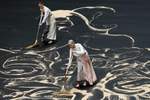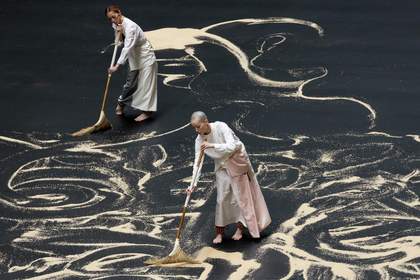You will need:
- Uncooked rice (sand or lentils would also work)
- Large sheets of black paper (A2 or A1)
- Tablets or cameras if possible


You will need:

Lee Mingwei
Our Labyrinth (2015–ongoing)
Tate
Your students don’t need to know anything about an artwork or artist to start exploring it.
Use these quick group activities to build their confidence and curiosity in sharing their first responses to the artwork. Some artworks they might like straight away, some they might not.
Discovering art can be new, exciting and sometimes confusing. There are no right or wrong ways to respond!
In pairs or as a group, take it in turns to imagine the artworks answering these questions and telling their story.
In pairs or as a group, use your body to respond to the artwork.
‘Can art be made out of attention itself?’
Lee Mingwei
Our Labyrinth 2015 transforms the simple act of sweeping into a performance, bringing a sense of ritual into the space it is performed in. It was inspired by Lee Mingwei's experience of visiting ancient temples in Myanmar, where paths leading to temples are swept by volunteers.
The performance features two dancers wearing sarongs with bells on their ankles moving slowly as they brush grains of rice into patterns. Their sweeping actions with the rice create a winding labyrinth-like path within a precise space similar to an ink pool.
The piece is not choreographed; the only instruction Lee gives the dancers is to ‘move very slowly, to listen to the rice, listen to yourself and also be aware of your partner’. Lee and the performers creating the artwork often describe it as a ‘gift’ to audiences.
Lee Mingwei creates participatory installations exploring issues such as trust, intimacy, and self-awareness. He often takes everyday interactions as his starting point, from eating and sleeping to walking and conversation. Lee is interested in the tension between the two dancers as they negotiate the space, responding to one another but also to their interior world. Lee has said his work is not about a particular culture, but about what it is to be a human being. There is no single ‘meaning’ but rather an opening up of different possibilities.
Our Labyrinth encourages you to think a bit differently about art making, using an unusual material and making something that doesn't last. In this activity, pay attention to the process of making and consider Lee’s question: ‘Can art be made out of attention itself?’
Adapt
Introduce other non-art materials to manipulate, thinking about their sensorial qualities. This could include familiar food items, like different pasta shapes or jelly, or objects from around your classroom.
Think about the materials through movement, sound and touch rather than words.
Try adding music – what does this change about the material?
4. Try to work in silence to hear the rice on the paper. Keep the following questions in mind
Who is leading, who is following?
How are you listening to each other?
How are you listening to the rice?
What are you feeling, thinking, remembering?
Do any pictures emerge?
What does it feel like to work with your partner, is it an easy collaboration or combative? Is it generous or bossy?
What would the words be if you started to talk?
5. Lee shares that for him, being partly Indigenous Taiwanese, rice is very sacred – a ‘celebration of life’.
How do you feel using food to make art?
6. If you have a tablet or camera in the classroom, record your performance. Try holding the tablet above the paper to only capture the hands within the frame of the black paper.
7. Return to Lee’s question. Share your experience and your reflections with your partner.
‘Can art be made out of attention itself?’
8. At the end of your lesson, gather together and watch all the videos on your whiteboard as a class. Find each other’s performances and celebrate the artworks you’ve just made!
What have you learned by experimenting with unexpected materials and yourselves?
How can you use art to connect with each other and with an audience?
Extend
Invite your students to be more adventurous with how they record the performances – they could zoom in or move around the performers, following their movements.
This could lead to an interesting discussion about performance art and how it is experienced – whether this is through the original event, through documentary photographs/film or through the memory of those who encountered it.
Making art is a powerful way to learn new skills, explore ideas and express ourselves creatively. Encourage your students to discover new materials, techniques and methods inspired by great artists at Tate.
1. Prepare
2. Explore (10 minutes)
3. Make (30 minutes)